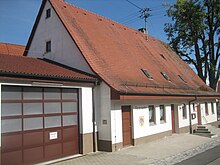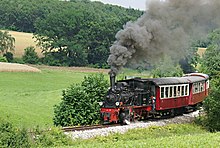Oppingen
|
Oppingen
Nellingen municipality
|
|
|---|---|
| Coordinates: 48 ° 32 ′ 28 " N , 9 ° 49 ′ 37" E | |
| Height : | 715 m above sea level NN |
| Incorporation : | 1st January 1975 |
| Postal code : | 89191 |
| Area code : | 07337 |
|
Oppingen
|
|
Oppingen is a village in the east of Baden-Württemberg that has belonged to the municipality of Nellingen since 1975 .
history
Oppingen was first mentioned in a document from 1108. The place was already called Oppingen at that time and is probably an Alemannic foundation from the 6th or 7th century, the place name would therefore probably go back to an Alemannic tribal prince Oppo. Since the place does not have a typical Alemannic Haufendorf settlement, but lies along an old crossroads, it could have been settled in Roman times or before and the place name can be traced back to the Roman word oppidum ("fortified place"). Since there are no finds from the Alemanni or Roman times so far, both explanations of the name remain speculative. In any case, at the time of the Romans a road led from Donnstetten to Urspring to connect the auxiliary fort of the Alblimes near Oppingen and after the Romans withdrew, the Alemanni ruled the area and settled it.
In the High Middle Ages, Oppingen probably shared history with neighboring Achstetten, which was later lost; Both villages seem to have belonged to court settlements in the possession of the Counts of Helfenstein , mentioned for the first time in 1113 , in which the Blaubeuren monastery, founded in 1085, also acquired ownership through donations . The central court of Oppingen was today's Thierer Hof . The town's buildings were lined up along the local road and the right-angled branches in the direction of Baurenhölzer and the former Roman road.
In 1356 the rule of Helfenstein was divided and Oppingen and Nellingen fell to Ulrich X. von Helfenstein. In 1396 the indebted Helfenstein sold the property to the imperial city of Ulm . Over the centuries, Oppingen remained a rural village, in which family farms dominated due to the consistently large amount of agricultural land, and there was no compulsion to part-time but also no settlement option for all- land tenants . The 21 farmsteads in the village, recorded in a Helfensteiner Saalbuch in 1415, remained unchanged until the 19th century.
Due to its affiliation with Ulm, Oppingen was not the scene of the German Peasants' War , despite its proximity to Geislingen an der Steige and Blaubeuren as centers of peasant unrest . Even during the Thirty Years War , Oppingen was initially spared from acts of war because of the Ulm protection alliance with Sweden of 1632, but was burned down by French troops in March 1647 together with Merklingen and Nellingen.
Oppingen belonged to the Amstetten office until 1649, to the Türkheim office until 1774, then to the Nellingen office. In 1802 Oppingen came first to the Electorate of Bavaria and finally in 1810 to the Kingdom of Württemberg , where it was subordinate to the Oberamt Geislingen , when the place was dissolved in 1938 to the district of Ulm .
On January 1, 1975, Oppingen was incorporated into Nellingen.
In contrast to some places in the area, industrialization did not have a noticeable effect in Oppingen. The population increased from 150 inhabitants in 1814 to 183 inhabitants by 1842 and remained almost constant thereafter. In 1982 148 inhabitants were counted. Today's settlement structure along the intersection of Nellingerstrasse / Hauptstrasse and Ortsstrasse practically follows the historic street village, although the site has outgrown the medieval settlement core on all sides thanks to the development of a few new areas.
coat of arms
The coat of arms of Oppingen, which was awarded to the municipality on December 16, 1952 by the regional council of North Württemberg, shows a black, striding elephant in a silver field and underneath a five-petalled rose, which is covered with green and covered with gold. The elephant indicates the earlier local rule, the Counts of Helfenstein . The rose reminds of the affiliation to the Ulm office of Geislingen .
Attractions
- Michaelskirche, built between 800 and 1200 AD, the tower and nave in their present form probably go back to 1591. The historic bell from 1592 was supposed to be melted down during the Second World War, but was found intact in Hamburg after the war and brought back to Oppingen. The organ from 1826 is the oldest organ in the church district.
- Glider airfield Oppingen-Au
- Albbähnle narrow-gauge railway
Individual evidence
- ^ Federal Statistical Office (ed.): Historical municipality directory for the Federal Republic of Germany. Name, border and key number changes in municipalities, counties and administrative districts from May 27, 1970 to December 31, 1982 . W. Kohlhammer, Stuttgart / Mainz 1983, ISBN 3-17-003263-1 , p. 543 .
literature
- Otto Fink: Chronicle of the municipality of Oppingen. 1983.



